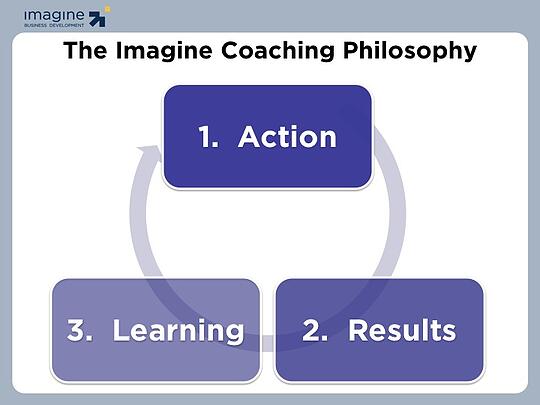Note to readers: This article appeared in our monthly newsletter The Demand Creator. It elicited some interesting response and some wanted to comment on it. I am posting this article here, so the conversation can begin.
We're interviewing to hire another coach to support our growth. A candidate asked me an obvious questions that elicited an interesting, unexpected response from me. What was my response?
“If you’re trying to improve performance from your sales team – buy-in doesn’t matter; actions do.”
“Ah,” you say, “but don’t you need buy-in to support the actions you want?” Over the last 20 years working with thousands of salespeople I’ve come to realize that the common answer is, “yes,” and the effective answer is “no, not really.”
At Imagine, we have a unique approach to supporting the growth of anyone – especially salespeople.
- Action: In our world, everything, and I mean everything, starts with an action. The reality is that nothing happens until someone does something. Talking about it doesn’t directly lead to progress.
- Results: Every action leads directly to a result of some sort. In our world, there are two types of results: Good results – the result of the action is what we expected.- Bad results – the result of the action is different from what we expected. This means something great, if unexpected, is a bad result. While this sounds counterintuitive, it’s a critical point. We’re trying to build purposeful, predictable performance. A great, yet unexpected, outcome means that further investigation is needed.
- Learning: From the result, good or bad, learning can take place, which plugs right back into driving the next action.

Most organizations focus on learning first. Focusing on learning first leads to a variety of barriers.
- It is at the learning stage where resistance occurs. The nature of “learning something new” triggers a fear response, which of course leads to a fight or flight action.
- At the learning stage, it’s all opinion. Sure, one may have experience, but experience is no match for the status quo.
- The biggest challenge in any change (and improving is a change) is that you are competing against inertia – a very powerful force. The only thing that overcomes inertia is movement, velocity, and ultimately momentum. Because there is no movement in learning, the initiative gets stuck or goes sideways.
- Humans, by and large, are not classroom learners. We are experimenters and roamers. When you focus on learning before doing, you are going against our natural programming.
Salespeople (and, usually, entrepreneurs) are action figures, they learn by doing. Every time (and again, I mean every time), we run into difficulties with our efforts, we are able to trace the cause of the problem to a focus on learning over action. While this sounds overly simple, the reality is that the action-result-learning process is a self-correcting mechanism.
Growth is spiral – it’s not linear. You don’t get better by dealing with a problem, situation, or stimulus once and then moving on; you get better by dealing with and constantly revisiting the issue and a deeper and more advanced level. As the wise saying goes, you don’t become a master by doing four thousand things; you become a master by doing one thing, four thousand times.
99% of improvement efforts are doomed to failure before they start. The reason is that step one is “get buy-in.” Management decides that something needs improvement then they start building the case. When they hit resistance, they must decide between two equally bad options:
- Engage the cynics, thus giving the resistance more credibility than it deserves grinding the forward movement to a trickle making it virtually impossible to overcome inertia, or
- Ignore the resistance, saying, in essence, we were just going through the motions.
Instead, focus on the action(s) that you want that represents the change you want to achieve. For example, don’t talk about the need to take a new approach to selling, instead develop a new questioning process and call for an increase in the number of the new questions that are asked.
When you focus on action first and learning last, buy-in takes care of itself.

 Doug Davidoff
Doug Davidoff